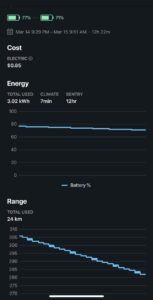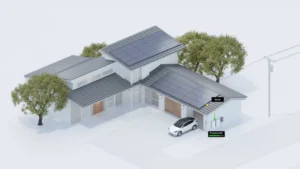Tesla Powerwall typically lasts over 10 years. Its lifespan depends on usage and conditions.
Homeowners often ask about its durability and efficiency. Understanding how long a Tesla Powerwall lasts is vital for anyone considering this investment. This device is not just a battery. It’s a smart energy system. Designed to store solar power, it provides backup during outages.
As solar power becomes more popular, knowing the lifespan of storage options is crucial. People want reliable energy solutions. They need assurance that their choice will last. Tesla Powerwall promises longevity and performance. But, what factors affect its lifespan? Let’s explore what makes it a sustainable choice. Discover how it can power homes efficiently over time.
Tesla Powerwall Basics
Imagine never worrying about power outages again. That’s the promise of the Tesla Powerwall. This sleek, wall-mounted battery system stores energy for your home, ensuring you have electricity even when the grid fails.
With its cutting-edge technology, the Powerwall is designed to integrate seamlessly into your home setup. But how does it work, and what makes it so reliable? Let’s break it down.
Battery Technology
The Tesla Powerwall uses lithium-ion batteries, similar to what’s in your smartphone, but much larger and more powerful. These batteries are known for their high energy density and long life. They’re designed to last for many years, ensuring you get the most out of your investment.
One of the standout features is the battery’s ability to cycle – charge and discharge – efficiently. This means it can handle daily usage without wearing out quickly. As a homeowner, you benefit from reliable backup power and peace of mind.
Key Features
The Powerwall comes packed with features that make it a top choice for home energy solutions. It offers a seamless switch from grid power to battery power, ensuring no disruption when outages occur. This is crucial if you’re working from home or have critical appliances running.
Another key feature is its ability to pair with solar panels. You can store solar energy during the day and use it at night, reducing your reliance on the grid. It’s a practical step towards energy independence and can save you money on your electricity bill.
But here’s a question for you: How would having a reliable energy source change your daily routine? Imagine the possibilities and the freedom to focus on what matters most. With Tesla Powerwall, you’re not just investing in technology; you’re investing in peace of mind and sustainability.
Battery Lifespan Factors
Tesla Powerwall’s lifespan depends on usage, temperature, and maintenance. Typically, it lasts around 10 years or more. Regular care and ideal conditions can help extend its durability significantly.
When considering how long a Tesla Powerwall might last, it’s crucial to understand the factors that influence its battery lifespan. Different elements impact the longevity of the battery, affecting how you can maximize its use and ensure optimal performance over time. Here, we break down the key aspects that influence the lifespan of a Tesla Powerwall.Charge Cycles
The number of charge cycles significantly impacts the lifespan of a Tesla Powerwall. A charge cycle occurs when the battery is fully charged and then used until it’s completely drained. Tesla Powerwalls are designed to handle thousands of these cycles efficiently. However, frequent deep discharges can reduce battery life more quickly. Imagine using your smartphone—if you constantly let it die before charging, it doesn’t last as long. Similarly, regularly charging your Powerwall before it drops to very low levels can extend its life.Environmental Impact
Environmental conditions also play a significant role in the lifespan of a Tesla Powerwall. Extreme temperatures, both hot and cold, can affect battery performance. Ideally, the Powerwall should be installed in a location with stable temperatures to avoid unnecessary strain. Consider where you live: if your area experiences harsh winters or scorching summers, you’ll need to think about installation options that mitigate these effects. A garage or basement might provide a more stable environment than an outdoor setting. Every Tesla Powerwall owner should ask themselves: Are you providing the best conditions for your battery? Taking steps to control the environment can make a substantial difference in how long your Powerwall serves you.Daily Usage And Efficiency
The Tesla Powerwall is a popular choice for many homeowners. It provides reliable energy storage for daily use. Understanding its daily usage and efficiency is crucial. This helps in maximizing the benefits of this innovative device. Efficient daily use can extend the lifespan of the Powerwall. It also ensures you get the most value from your investment.
Energy Consumption Patterns
Energy consumption varies from home to home. Some households use more energy during the day. Others may consume more at night. Analyzing your home’s energy patterns is vital. This helps in optimizing the Powerwall’s efficiency. Knowing peak usage times aids in better energy management. Adjust usage to reduce strain on the Powerwall.
Optimization Strategies
There are several strategies to optimize Powerwall usage. First, consider using energy-efficient appliances. This reduces overall energy demand. Second, schedule heavy energy tasks during off-peak hours. This allows the Powerwall to recharge efficiently. Third, use smart home systems to monitor energy usage. They help in adjusting consumption patterns automatically.
Regular maintenance also plays a significant role. Keep the Powerwall in a good environment to maintain efficiency. Follow Tesla’s guidelines for optimal performance. These strategies can enhance the Powerwall’s daily efficiency. They ensure it lasts longer and serves better.

Credit: www.skylinesolar.com.au
Maintenance And Care
Understanding the maintenance and care of your Tesla Powerwall is crucial. Proper maintenance ensures longevity and efficient performance. Regular checks help identify potential issues early. Keeping your Powerwall in top shape guarantees optimal energy storage. This section explores routine checks and offers troubleshooting tips.
Routine Checks
Schedule regular inspections for your Tesla Powerwall. Check for physical damage or unusual noises. Inspect connections and cables for wear. Ensure the unit is clean and free from debris. Dust and dirt can affect performance. Look at system software updates for improvements. Regular updates enhance efficiency and security.
Troubleshooting Tips
Identify common issues with simple checks. Verify power supply connections if problems arise. Examine battery status through the app. Check if the Powerwall is charging correctly. Restart the system to fix minor glitches. Consult the manual for specific error messages. Seek professional help for persistent issues.
Real-world Performance
Tesla Powerwall typically lasts around 10 to 15 years. Its lifespan depends on usage and environmental conditions. Regular maintenance can help maximize its efficiency and longevity.
When considering a Tesla Powerwall, understanding its real-world performance is crucial. Many potential users ask: How does it hold up over time? It’s one thing to look at specs, but actual user experiences offer invaluable insights. Let’s delve into how the Powerwall performs in everyday situations, backed by genuine stories and case studies.User Experiences
Real people using Tesla Powerwall have shared some fascinating insights. One homeowner noted that their Powerwall reliably powered their essentials during a recent blackout. They found it reassuring to have uninterrupted power for critical devices. Another user appreciated the seamless integration with their solar panels. They highlighted the satisfaction of reducing their electricity bills while maintaining a sustainable lifestyle. These experiences underline the Powerwall’s ability to deliver both reliability and savings. Could the Powerwall be the missing piece in your energy puzzle? Users often emphasize the peace of mind it brings, knowing they have a dependable power backup.Case Studies
Recent case studies provide a more analytical look at the Powerwall’s performance. A community project in California utilized several Powerwalls to stabilize energy supply across multiple homes. This setup not only enhanced energy security but also contributed to grid stability during peak hours. In a rural area, a farm deployed Powerwalls to manage power fluctuations. This case study showed a significant reduction in downtime and operational costs. The farm experienced a smoother workflow, thanks to consistent energy access. Both cases reveal how the Powerwall adapts to different needs, whether for individual homes or larger community projects. It’s fascinating to see such versatility in action. Are you considering a Powerwall for your own setup? These real-world insights might just help you make an informed decision.
Credit: www.youtube.com
Comparing Lifespan With Alternatives
Tesla Powerwall typically lasts around 10-15 years, providing reliable energy storage. Alternatives may offer different lifespans and efficiency. It’s important to compare these options based on your specific energy needs and budget.
When considering home energy storage, understanding the lifespan of different battery options is crucial. The Tesla Powerwall is a popular choice, but how does its longevity compare to traditional batteries? Evaluating lifespan can significantly influence your investment decision. You might wonder if the higher upfront cost of a Powerwall justifies its lifespan compared to cheaper alternatives. Let’s explore these aspects to help you make an informed choice.Tesla Vs Traditional Batteries
Tesla Powerwall is renowned for its long lifespan, offering a warranty of 10 years. Many users report the Powerwall exceeding this period with proper maintenance. In contrast, traditional lead-acid batteries typically last 3 to 5 years. Lithium-ion batteries, like those in the Powerwall, degrade slower than lead-acid, offering consistent performance over time. Consider a friend who switched from lead-acid to a Tesla Powerwall. They found fewer replacements and less maintenance hassle over a decade. Which would you prefer: frequent battery changes or a one-time investment that pays off in the long run?Cost-benefit Analysis
At first glance, the Tesla Powerwall might seem expensive. However, when you factor in its lifespan and efficiency, the cost per year becomes competitive. Traditional batteries may cost less initially, but frequent replacements can add up quickly. Think about your energy needs over the next decade. A Powerwall could provide peace of mind with its reliability and lower total cost of ownership. Would you rather spend more upfront for long-term savings, or opt for a cheaper solution with recurring expenses? Engaging in a cost-benefit analysis can help clarify these points. For instance, list the potential savings on electricity bills and reduced maintenance costs. How do these figures stack up against the initial investment? By comparing the Tesla Powerwall with traditional batteries, you can better understand which option aligns with your energy goals and financial plans. Consider your priorities and make a choice that suits your lifestyle.Technological Advancements
The Tesla Powerwall has seen remarkable progress over the years. These advancements have significantly improved its lifespan and efficiency. From innovative features to future improvements, the Powerwall continues to evolve.
Understanding these technological shifts is crucial. It provides insights into how long the Powerwall can last. Let’s explore the key upgrades and what the future holds.
Innovative Upgrades
Recent upgrades have greatly enhanced the Powerwall’s performance. The integration of high-density batteries increases its capacity. This means longer usage without frequent recharges.
Advanced thermal management systems are now included. They help maintain optimal temperature, preventing overheating. This contributes to a longer lifespan.
Software improvements play a crucial role too. Smart algorithms optimize power distribution. This ensures efficient energy use and prolongs battery life.
Future Prospects
Future advancements promise even greater longevity. Researchers are exploring new battery materials. These materials may offer better durability and energy storage.
Automation is another exciting prospect. Automated systems could predict energy needs. This would optimize usage and reduce wear on the battery.
The Powerwall’s lifespan could soon extend beyond current expectations. Emerging technologies and research will drive these changes. The future looks promising for Tesla’s Powerwall.

Credit: ev-lectron.com
Maximizing Battery Life
Maximizing the battery life of your Tesla Powerwall ensures long-term efficiency. Proper care can extend its lifespan, saving you money. Understanding effective storage and smart energy management is key. Let’s explore these essential strategies for a healthier Powerwall.
Effective Storage Solutions
Store your Powerwall in a cool, dry place. Avoid direct sunlight or extreme temperatures. Consistent climate control prevents battery degradation. Keep it away from water sources to avoid damage. Regularly check for dust and clean it gently.
Smart Energy Management
Use energy during off-peak hours. This reduces strain on the Powerwall. Monitor your energy use with Tesla’s app. It helps optimize charging and discharging times. Avoid rapid charging to extend battery life. Consistent, moderate charging is best.
Frequently Asked Questions
How Long Will A Tesla Powerwall Power My House?
A Tesla Powerwall can power a home for 7 to 24 hours, depending on energy usage and battery capacity. High consumption decreases duration, while minimal usage extends it. For optimal performance, consult with an expert to assess your home’s energy needs and usage patterns.
How Many Years Will A Tesla Powerwall 3 Last?
Tesla Powerwall 3 typically lasts around 10 to 15 years. Its lifespan can vary based on usage and maintenance. Regular check-ups can help maximize its efficiency and longevity. Investing in a Powerwall offers reliable energy storage, supporting sustainable living and reducing electricity costs.
What Is The Average Life Of A Tesla Powerwall?
A Tesla Powerwall typically lasts 10 to 15 years. Its lifespan depends on usage and environmental factors. Regular maintenance can help maximize its longevity. It offers sustainable energy storage solutions for homes, enhancing energy independence and efficiency. Tesla provides a warranty to ensure reliable performance during its lifespan.
How Long Will Powerwall Run My Ac?
Powerwall can run your AC for 3 to 8 hours, depending on its energy storage capacity and AC power consumption. Battery health and home energy usage affect duration. Monitor usage to maximize efficiency and run time. Ensure your Powerwall is fully charged for optimal performance.
Conclusion
Tesla Powerwall offers reliable energy storage for many years. Its lifespan depends on usage and maintenance. Most last over 10 years, providing consistent backup power. For optimal performance, follow Tesla’s guidelines. Regular checks and updates help extend its life. Investing in a Powerwall can cut energy costs and reduce dependence on the grid.
Consider your home’s energy needs before buying. With proper care, Tesla Powerwall is a solid choice for sustainable energy. Enjoy peace of mind knowing your home has a dependable energy source. Make a smart decision for your future energy needs.


